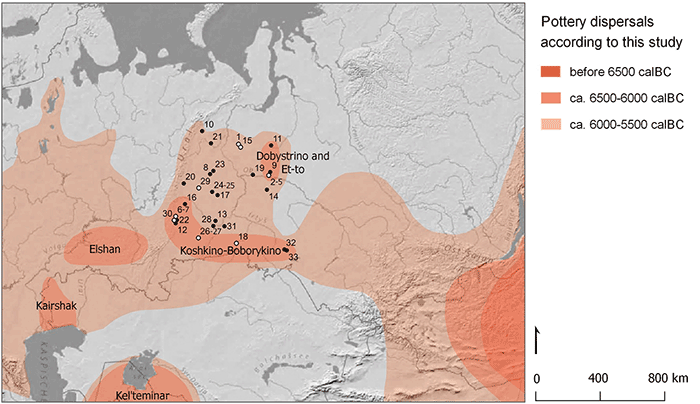This post is part of a draft on palaeolinguistics and the Proto-Uralic homeland. See below for the color code of protoforms.
8. Technology
8.1. Pottery
PU (Fi., Ma., Kh., Ms., Hu.) *pata ‘pot’ (UEW Nº 710) has a striking resemblance with NWIE *pod-óm, cf. PGmc. *fatą ‘vat, vessel’, Lith. púodas ‘pot’ (Kroonen 2013: 131; Dérksen 2015: 372). However, a Pre-PGmc. origin of a PFU stem seems unlikely – based on the lack of any other case with such a large distribution. Assuming that an unattested PIIr. **padá- underlies the PU form (cf. Parpola & Carpelan 2007: 122) seems unwarranted. A NWIE borrowing from Uralic is phonologically implausible.
NOTE. Most NWIE loans proposed by Koivulehto have today a more clearly eastern, Indo-Iranian (or more rarely western, Balto-Slavic) origin. An indisputable NWIE borrowing is a rarity (Holopainen 2019: 192), and would be so based on its distribution, since it might be phonologically impossible to distinguish from a Late PIE borrowing.
PFP (Saa., P) *porta ‘vessel’ (UEW Nº 1499) ← Pre-PIIr. *pōtro- or PIIr. *pātra-; maybe from an earlier PIE form *pōtrom – i.e. if not *pōtlom – ‘instrument for drinking’, from root *peh₃- ‘to drink’ (Holopainen 2019: 193 with references).
Pre-PP. *poči-/*poši- ‘to boil’ ← P(I)Ir. *pač-a- ‘to boil’ (cf. YAv. hąm.pacaiti ‘boils’), from PIE *pekʷ- ‘cook’ (Holpainen 2019: 174-175).
NOTE. More unlikely is the parallel borrowing of PSaa. *poartē from a Pre-PGmc. form behind *fōdrą ‘fodder’ (Koivulehto 1999). Both words – ‘vessel’ and ‘to boil’ – possibly related to ritual set of shared mythology (cf. also *takra ‘piece of flesh’, see below).
PFP (Fi., P) *waŋka/*we̮ŋka ‘hook; handle (of a vessel)’ (UEW Nº 1689) ← P(I)Ir. *wanka- ‘crooked’ → POUg. *wǟŋkVrV ‘hook’ (Holopainen 2019: 297-298 with references).
PWU (Fi.?, Md.?) *śaŋka/*ćaŋka ‘handle; hook’ (UEW Nº 1197) ← PIIr. *ćanku- or Pre-PIIr. *kʲanku. Maybe PFi. from PGmc. *stangō ‘bar’.
Forager ceramic emerged quite late on the southern fringes of the taiga around the Urals and the West Siberian forest-steppes, at the end of the 7th millennium BC, not connected to the preceding Late Pleistocene ceramic traditions of Trans-Baikalia and further East. It spread rapidly to the west and north, covering most of the Pontic-Caspian steppes and forest zone before (Middle Eastern) Neolithic pottery traditions appeared in Centra-East Europe and in the Bug-Dniester area. Hunter-gatherer pottery was also accompanied by a unique set of innovations and intensification in the settlement system and the socio-economic sphere, such as (1) appropriation of vast previously barely settled regions, (2) the emergence of complex and even fortified settlements, and (3) of ritual mounds (Piezonka et al. 2020).
Different traditions of hunter-gatherer pottery spread through Eastern European Mesolithic and Neolithic groups in continuous contact with each other (Mazurkevich & Dolbunova 2015), but all borrowings in this field can be attributed to the late intense trade and religious ties with Proto-Indo-Iranians (v.i. Mythology & Metallurgy).
8.2. Wheel and Cart
PWU (Saa., Fi.) *kekrä ‘wheel’ ← Pre-PIIr. *kekro- ‘wheel’ → PIIr. *čakrá-. The limited distribution of the loan despite its clearly ancient nature indirectly supports a very important feature of Indo-Iranian borrowings: the earliest demonstrably Pre-Proto-Indo-Iranian layer was in contact with an already disintegrating Uralic community (Holopainen 2019: 118-119 with references).
NOTE. Adding here Saa.N *geavly ←? Early Pre-PIIr. *keklä would be even more interesting, if Kümmel (2018) is right about its Pre-PIIr. origin, hence also potentially Late PIE, since it would further support different early Indo-European layers replacing each other at a very early stage of Uralic disintegration. Nevertheless, a borrowing from Pre-PGmc. *kʷekla- → PGmc. *hʷehla-, as originally proposed by Koivulehto (2000), is also possible and probably more attractive based on their known contacts. The parallel borrowing of PFi. *koljo ‘wheel’ ← NWIE/(Pre-)PBSl. *kʷol-, cf. PSlav. *kolo/*koles- (Holopainen, Junttila & Kuokkala 2017) might also reinforce this idea.
PFU (Saa., Fi., P, Ms.?, Smy.?) *aja- ‘to drive; to chase, hunt’ (UEW Nº 4) ← Pre-PIIr. *agʲa- ‘to drive’; dubious mainly because it is one of the few (and the most certain) example of a PU glide ← IE palatovelar. Irregular cognates PMs. *ajt- and PSmy. *åjtå- suggest a potential borrowing through an unattested PKh. **ajt- (Aikio 2020: 7-8 with references).
NOTE. Assuming that palatovelars cannot be reconstructed for Core Indo-European or earlier stages (and that the change postdates thus its disintegration), it could potentially fit Proto-Balto-Slavic, too. Arguably, a loan related to the abstract set of shared mythology with Proto-Indo-Iranians is possible, but its early widespread adoption in Proto-Uralic strongly supports a Pre-Proto-Indo-Iranian origin, as does its reconstructed meaning likely related to either hunting or herding (see above *wetä). On the other hand, assuming that palatovelars were reconstructible for the parent language – which does not seem warranted based on the earliest PIE ~ PU loan layers – the borrowing could be from the parent Core Indo-European/Indo-Tocharian stages, from a period after the evolution of PIE **h₂egʲ- into **hagʲ- → **agʲ-.
PUg.? (Kh., Hu.) *śäkärä ‘sledge’ ← PIIr. *śakarta-, *śakartī́?, cf. O.Ind. śakaṭa-, śakaṭī́- ‘cart, wagon, car, carriage’. Dubious because of the potential origin of the Pre-PKh. form in PIr. (Holopainen 2019: 256 with references), but – since it is not attested in Iranian derivatives – most likely an earlier, PIIr. borrowing.
Chariot age
The early borrowing of a word for wheel is particularly interesting from a chronological perspective, due to its association with the development of the cart. The Digital Atlas of Innovations for Wheeled Vehicles by Florian Klimscha, gives a good overview of their expansion, showing that before the spread of Andronovo, only some early (Afanasievo-related?) petroglyphs appear to the east, and the forest zones of north-eastern Europe show only two finds of miniature disc-wheels, both in Balanovo contexts. The diffusion of two-wheeled vehicles that happened at the end of the 3rd millennium throughout the Pontic-Caspian steppes, appearing first in Catacomb-related contexts, was probably already associated with Pre-Proto-Indo-Iranians (cf. Chechuskov & Epimakhov 2019, Lindner et al. 2020).
NOTE. There are some problems with the visualization tool. The Catacomb site Borovkovka is erroneously located in an eponymous location of the Trans-Urals. If you click on the different dots, some Asian pre-2000 BC sites with wheel-related finds belong to Andronovo or even later periods.
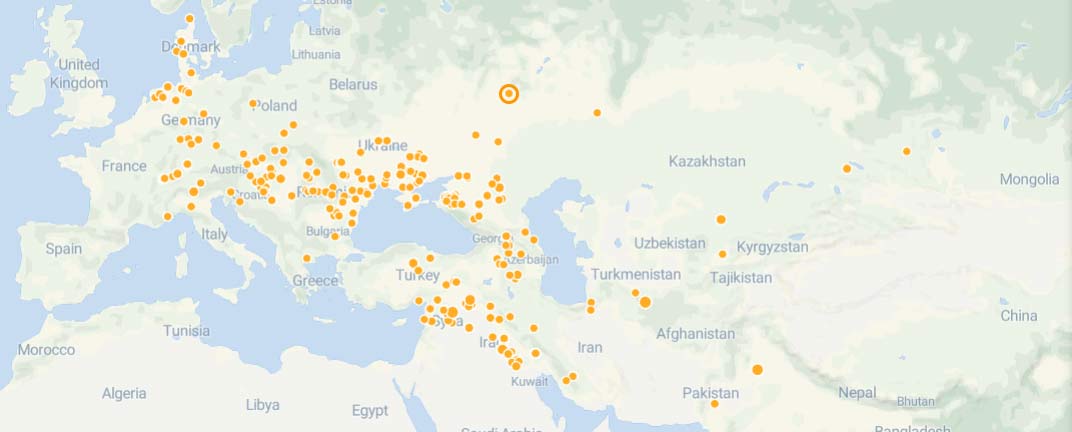
8.3. Textiles
PU (Saa., Fi., Ma., P, Smy.) *äjmä ‘needle (sewing)’ (UEW Nº 37).
PWU (Saa., Fi., Md.) *šiša/*iša ‘sleeve’ (UEW Nº 1235; Aikio 2015:45).
PFP (Saa., Fi., Md., Ma., P) *(j)iša-? ‘skin; leather’ (UEW Nº 1249). Irregular sound correspondences suggest that it belongs to the Agricultural Substrate (Holopainen 2019: 93-95 with references).
PWU (Sa., Fi., Md. → Ma.?) *kečrä ‘spindle’ (UEW Nº 1294) ← Pre-PIIr. **ketˢtram → PIIr. *čactram ‘spindle’, cf. Skt. cāttra (Holopainen 2019: 117-118 with references). PMa. *šǚδər potentially an internal borrowing from Mordvin (Parpola 2017), but no other such examples are known.
NOTE. The word is assumed to derive ultimately from PIE root *kr̥t ‘spin’ and instrumental suffix *-tro- or *-tlo-, both formations yielding interdental *-tˢt-. About the discussion of PU *čr ← Pre-PIIr. *-tˢtr- vs. an assumed Pre-PIr. **-str- by Holopainen, the source in Pre-Proto-Indo-Iranian is more attractive because this derivative is only found in Indo-Aryan; a later Pre-PIr. loan is uncompelling due to its phonology and chronology, and because it shows a regular output in PWU. Compare from the same IE cognate PP *ćers ‘spindle’ ← PIr. *častra- ‘spindle’, clearly adopted at a later period (Holopainen 2019: 378 with references).
PFP (Saa., Md., Ma) *rećmä ‘rope’ (UEW Nº 1522) ~ Pre-PIIr. **rećmi- → PIIr. raćmíš, cf. OInd. raśmí- ‘rope, string, cord; rein, bridle, leash’, from root rać- ‘bind’. No cognates outside Indo-Iranian, which makes the origin and direction of borrowing unclear.

Spindle-whorls are tools for twisting fibers and making threads, and as such became commonly associated with the advent of the Neolithic – i.e. with the intensive use of plant fibres to manufacture textiles. Their spread can be thus linked to the expansion of the Neolithic package from the West (Maner 2018) or the East (Furusawa 2007), but in any case it was certainly present among Early European Farmers and in the Eneolithic steppe (cf. Morgunova & Turetskij 2016).
8.4. Dwelling & Construction
PU *kota ‘house, home; hut, tent’ (UEW Nº 370) ~ P(I)Ir. *kata- (cf. YAv. kata- ‘storage room, cellar’, Persian kad ‘house’), PSlav. *kotъ ‘booth, sty’ (ESSJa points out that in the culture of the early Slavs sties for domestic animals may have been dug out), OE heaðor n. ‘incarceration, jail’ (Derksen 2008: 241), or Toch. B koto ‘crevice, hole in the ground, pit’ (Adams 2013: 215). Maybe here also Lat. casa ‘cottage, hut’, probably a loanword (De Vaan 2008: 96), as well as Gk. kotulé and Lat. catinus, for all of which a PIE root **kēt-/**kot- ‘hut’ has been proposed (Tischler 2002: 484).
The semantic parallelism and phonological equivalence between the Proto-Uralic and Proto-(Indo-)Iranian words makes them unlikely independent formations. If ultimately Uralic and not from a third common source, an original meaning ‘pit house’ seems the most likely one behind Indo-European substrate loans. Uralic loans into Tocharian or Pre-Grimm Germanic (earlier than the certain loan into PGmc. *kutan) are conceivable, but the isolated attestations make it difficult to propose with certainty anything other than a quite early Wanderwort. Uralic or Iranian probably also behind Slavic, Mongolian hot ‘town’, and Turkish kodak ‘home’.
Pit houses – with floors intentionally deepened or sunk into the natural layer – appear in Eastern Europe since the Palaeolithic, but they seem to be limited in their spread; for example, in Estonia they only appeared occasionally in coastal areas during the Comb Ware period (Khrustaleva et al. 2020), in the Baden culture they appear in hill top sites from Bohemia and Moravia (Turek 2013), etc. Within the Corded Ware culture, houses or huts with partly sunken floors are not rare (Müller et al. 2014), and this tradition was continued by Bell Beakers in the Northern Province (Sarauw 2013), as well as in houses and huts of Abashevo and Srubnaya-Andronovo settlements (Kuz’mina & Mallory 2007, passim), which would culturally connect all loanwords above. However, it is unclear how their different construction and function might relate them with each other (Macphail 2017: 425-432)
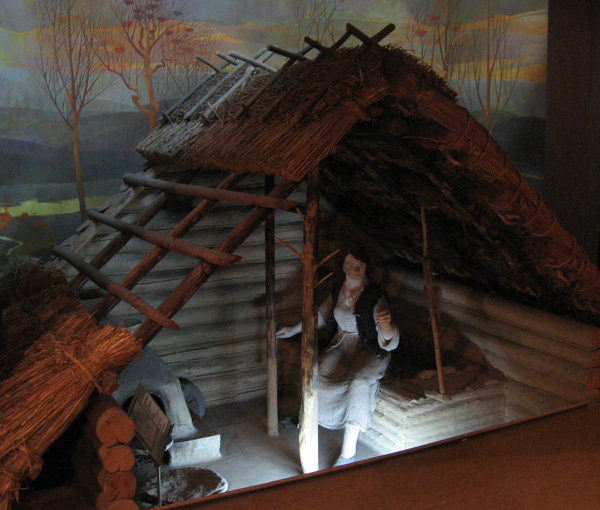
Interesting in this regard is also PSmy. *tät ‘tent roof made of birch bark’ ← Pre-PSmy. *täši ← P(I)Ir. *ta(ć)šja- ‘to be formed (out of wood etc.)’ (Holopainen 2019: 289-290 with references).
PFP (Fi., Ma.?, P) *tala (*tala-sV) ‘shelter; hut’ (UEW Nº 1022; Aikio 2015: 56) ← Pre-PBSl. *tolos (cf. PBal. *patalas ‘bed’, PSlav. *potolъkъ ‘ceiling’), cognate with PGmc. *þiljǭ ‘board, floor’. Derivations from *stālas (cf. ON stóll ‘chair’) or O.Ind. tala- ‘surface, level’ are unlikely (Holopainen 2019: 272-273 with references).
PFU? (Fi.? Kh., Ms., Hu.) *palxV ‘village’ (UEW Nº 697).
Pre-PP *gert(t)ä/*kert(t)ä ‘house, village’ ← P(I)Ir. *gr̥da- or Pre-PIIr. *gʰr̥dʰ-, cf. O.Ind. gr̥há- ‘house, dwelling-place’, also in Av. gәrδәa ‘dwelling-place of demonic beings’ (Holopainen 2019: 88-89 with references).
PFU? (Saa., P, Ms., Hu.) *aďo ‘bed’ (UEW Nº 3; Aikio 2015: 37).
PFP (Md., P) *sejti/*seti ‘bridge’ (UEW Nº 1552) ← Pre-PIIr. *seitu, cf. O.Ind. sétu- ‘binding; bond, fetter; dam, bridge’, Av. haētu- ‘dam’ (Holopainen 2019: 226-227 with references).
PU (Saa., Fi., Md., P, Kh., Ms., Smy.) *woča ‘fence’ (UEW Nº 1155; Saarikivi 2020: 72). Meaning extended to ‘village’ in Md., Kh., Ms., Selkup derivatives.
PU? (Fi., Kh.) *ajta/*e̮jta ‘fence’. It has been argued that PFi. *aita is a loan from PGmc. *aidja- ‘isthmus’ (← ‘passable way’) ← PIE *ei- ‘go’, also found in PSaa. *ājδō and *ājδē, but Aikio (2020:10-11) considers both more likely ultimately from a Proto-Uralic word.
Pre-Saa.? *ćero ‘fell-top’ ←? PIIr. *ćr̥a, cf. O.Ind. śira- ‘head’. Based on the difficulties reconstructing an equivalent protoform, it probably belonged to the layer of Paleo-European borrowings in Saami (Holopainen 2019: 77-78 with references).
9. Trade
9.1. General
PU (Saa., Fi., Md. P?, Kh., Ms., Smy.) *mexi-/*me̮xi- ‘give/sell’ (UEW Nº 542). A dubious borrowing from PIA (see below).
PFU (Saa., Fi., Ma., P, Kh., Ms.) *wosa ‘product, trade’ (UEW Nº 1170) ←? PIA *wos-n̥ ‘sale’ or PIA/PIE? *wos-e-i- cf. Hitt. 2sg. wašti, 3sg. wāši ‘purchase, acquire’ (Bjørn 2017: 118 with references).
NOTE. The PIA n-stem noun meaning ‘sale’, *wos-n, gen. *us-en-s, is inferred from zero-grade Hitt. ušnije/a-ᶻⁱ (Kloekhorst 2008). It is found already thematicized in LPIE, as *wosno- behind Gk. ὦνος and as *wesno- behind Lat. vēnum, Arm. gin, gen. gn-oy ‘purchase-price’, with Skt. vasná ‘purchase-price’ showing ambiguous root vocalism (Beekes 2010: 1680-1681). LPIE verb *wosn-eje- is thus behind Skt. vasnayáti ‘to higgle’ and Gk. ὠνέομαι ‘buy’, which makes a late borrowing into PU unlikely.
Two more isolated cases of PU *ks ← PIr. *dz rely on each other for support as borrowings and might belong in this field, but in a much later chronological layer:
- PWU (Fi., Md.) *maksa- ‘to pay’ ← PIr. *ma(n)dza-, cf. Av. mąza.raii ‘giving wealth’ (Holopainen 2019: 131 with references).
- PFi. *paksu ‘thick’ ← PIr. *dbadzu-, cf. O.Av. bəzuuant- ‘thick’ (Holopainen 2019: 173 with references).
9.2. Salt
PFP? (Fi., Md., Ma., P) *salV ‘salt’ (UEW Nº 1534) ← PIE/NWIE *sal-/*sāl-. Its phonology and its absence in all attested Indo-Iranian dialects excludes a priori PIIr. – although cf. O.Ind. salilá- ‘an epithet of the ocean’ (←? ‘salty’?).
NOTE. Possibly later, parallel cultural borrowings from (Pre-)PBSl. *sal-/*sāl- or less likely PBal. *sāls (cf. PSlav. *solь) that “spread as some kind of Wanderwort whose exact route is difficult to track” (Holopainen 2019: 214-216 with references). However, the lack of precise correspondences and the need for multiple ad hoc assumptions about the different reconstructions makes a Late PIE loan with later irregular outputs equally possible, as is a common substratal origin for both, PIE and PU protoforms.
Salt also belongs to the Neolithic package, and its trade might have been particularly important for the “salt-starved region” of the Cucuteni-Trypillia culture. Nearby sites included Provadia-Solnitsata during the 5th millennium BC, at roughly the same time as the neighbouring Varna Chalcolithic cemetery was in use, which – given its exceptionally rich grave inventory – might be assumed to have belonged to the same Hamangia-Sava ethnocultural community (Nikolov 2012, Weller 2012). Later, throughout the 4th millennium, the clusters of coastal salt extraction lakes (limans) along the shores of the Northern Black Sea might have offered part of the production needed by the Trypillian population (Mircea & Alexianu 2007).
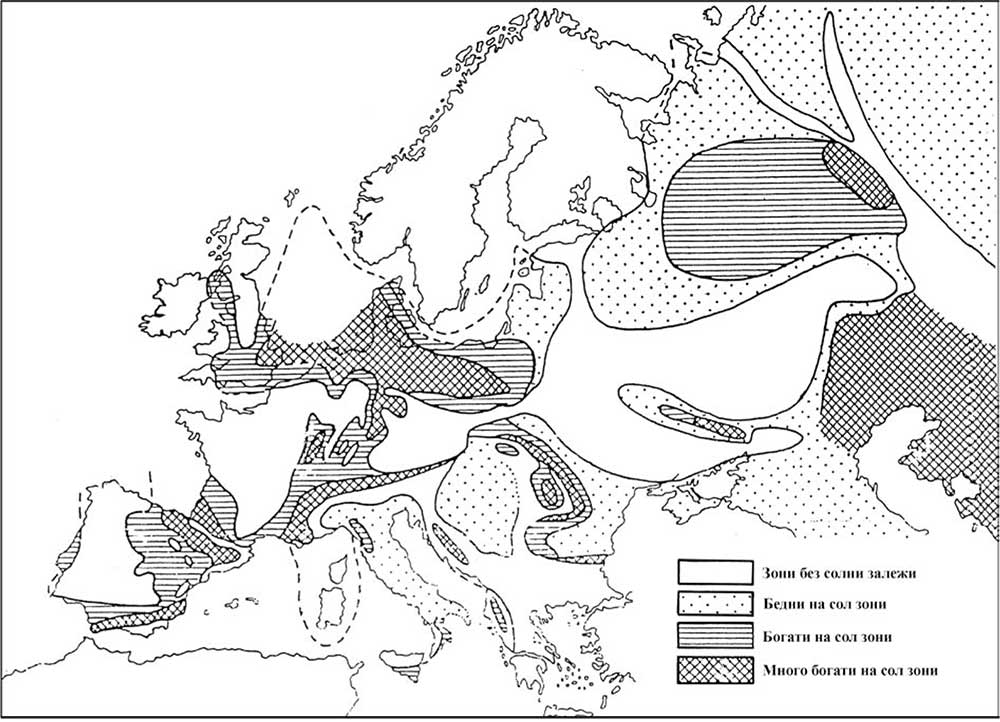
Salt was an exchange commodity in its own right, but also important for farming societies (unlike for hunter-gatherer societies), since food preservation (including also smoking or drying) was essential for survival during long periods of winters and droughts. During the 3rd millennium BC, before the emergence of the Bell Beaker culture, evidence for salt production is practically confined to south-western Europe. Groups inhabiting salt-poor areas must have continued to rely on the supply of salt from the main production areas of the Neolithic and Chalcolithic (Guerra Doce 2016). Only ‘during the Bronze Age organised salt production becomes an everyday matter in many areas, and in some that production arguably reached industrial proportions’ (Harding, 2013a: 88).
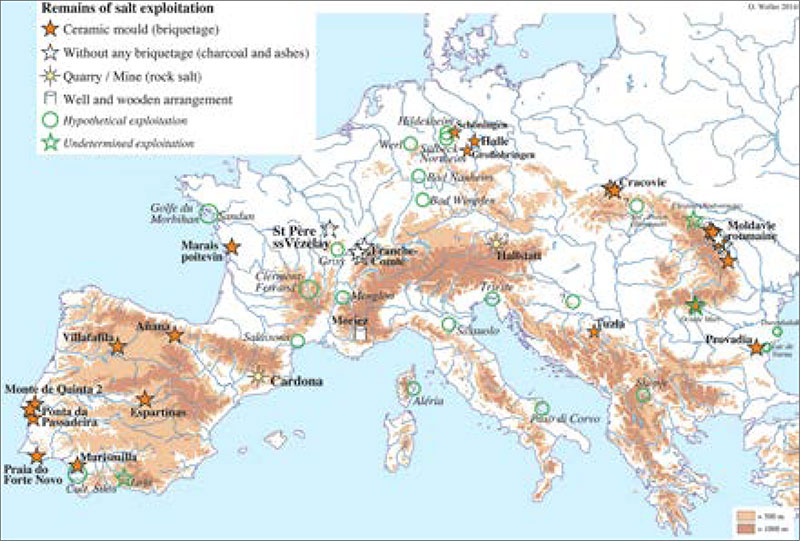
9.3. Slavery
PFU (Fi., Hu.) *arwa (*e̮rwV?) ‘price’ ← (Pre-)PIIr. *arg(ʷ)ʰá- (Holopainen 2019: 68-70 with references). The underlying PIE *algʷʰós ‘price’ (cf. Gk. alphḗ, Lith. algà) has been linked to the human value of slaves (cf. Benveniste 1969: Purchase and Redemption).
NOTE. Its phonology seems especially compatible with a Pre-Proto-Indo-Iranian stage, if the merge *l̥ → *r̥ is assumed to have happened before (or concurrently with) *gʷʰ → *gʰ, i.e. proposing an intermediate or at least variable stage Pre-PIIr. **argʷʰ- → (Pre-)PIIr. *argʰ-. The substitution of labiovelar *-rgʷʰ- for PU *-rw- seems phonologically more straightforward, even if there are no other known examples. Holopainen’s preference for Aikio’s (2020: 29) proposal of separate borrowings through a spirantized reflex *-rɣ- (cf. Ossetic arɣ) needs assuming some “Pre-Alanic” form that could be behind Proto-Finnic. However, this evolution seems not particularly easier to justify (lacking any other similar example) than from PIIr. *gʰ or Pre-PIIr. *gʷʰ, and this kind of language contact also lacks support from other borrowings attested in (Pre-)Proto-Finnic.
PFP (Saa., Fi., Md., Ma., P) *saxi- ‘to get, obtain’ ← PIIr. *saʒ́ʰ- ‘to hold; to overpower’ (← PIE *segʰ-e-, cf. Gk. ἔχω ‘to have, obtain’) cf. O. Ind. sah- ‘to vanquish, overcome, conquer, be victorious, have power, gain (battles etc.)’, Av. *haz in noun hazah- ‘power, violence; superiority’ (= Vedic sáhas-) (Koivulehto 1999:227). It might belong to the vocabulary for slave trade, because of the specific semantic shift assumed from PIIr. (probably more general in PIE or Pre-PIIr.) and the likely origin of most slaves in foreign captives, inferred from the vocabulary in this set (a trend visible also among Indo-Europeans, cf. Benveniste 1969: The Slave and the Stranger).
NOTE. Parpola’s (2010: 313) proposal of a borrowing from root PIIr. **saH- ‘win, reach, get, obtain’ is semantically straightforward, but it is based on the controversial assumed presence of a merged laryngeal (or even laryngeals!) in this context in PIIr. or even later (Kümmel 2018: 169-170), which lacks any external support from many other Uralic loanwords, despite Holopainen’s (2019: 209-210) preference for it (see *wāta below). Furthermore, it is unclear from which exact zero-grade variant the authors consider this a likely borrowing (an aorist **á-sah₂-C?, a perfect **se-sah₂-C?, etc.), and why this laryngeal appeared here but not in any other (Pre-)PIIr. borrowing. In fact, Holopainen (2019: 72-74) cautioned earlier in his text against deriving loanwords from complex forms (perfect, suffixed, reduplicated…). Despite the less attractive semantics, the traditional explanation based on a clear phonological correspondence remains the most compelling one.
PFP (Saa.?, Fi., Md., P) *orja ‘slave’ (UEW Nº 1459) ← (Pre-)PIIr. *ā́rja- ‘Aryan’, the autonymic Indo-Iranian ethnonym (cf. O.Ind. ā́rja-, Av. airiia-, O.Pers. arija-).
NOTE. The comparison is semantically and phonologically difficult for PSaa. *oarjē ‘south, west’ (← ‘southern slave’?), which possibly does not belong with the rest of the set. The meaning ‘slave’ is comparable to the eventually widespread use of Lat. sclavus ‘Slav; slave’ (ultimately from the Slavic autonymic ethnonym) in the Early Middle Ages, which implies in this case that Indo-Iranians might have been frequently traded as slaves in the early Uralic-speaking world. The possibility of an IE etymology for the PIIr. form is highly disputed: as a derivative of PIIr. *arí- ‘guest’, it would be comparable as O.Ind. arjá- ‘kind, hospitable’ with PCel. *arjo- ‘free man’ (Matasović 2009: 43). Depending on the original IE vocalism proposed, the word could be an earlier PIE borrowing, but the vrddhi form attested only in Old Indic might support that the source (or target?) was the Indo-Iranian branch. Based on the other words for (slave) trade, most likely a (Pre-?)Proto-Indo-Iranian loanword akin to the example of Lat. sclavus, even if the ultimate origin and dispersal in both branches is impossible to discern.
PU (Saa., Ms.) *pätäri- ‘to flee, escape’ ← P(I)Ir. *pataru-, *patarah, cf. Skt. patáruḥ, pataráḥ, ‘flying; fugitive’, Avestan patarǝ-ta- ‘flying’ (Aikio 2013). Possibly belonging in this set instead of the PIIr. religious one because of its wide reach in West Uralic and for a similar semantic connection as *saxi- ‘to get, obtain’.
NOTE. Despite Holopainen’s (2019: 198) comment about a semantic shift from ‘fly’, the word and its PIE cognates show that PIE *péth₂eti ‘to fall; fly’ was commonly associated with ‘to flee’, too, cf. Hitt. pattaiⁱ-/patti- ‘to run, fly, flee’, ᴸᵁpattejant- ‘fugitive’, etc.
Slavery was certainly known in Early Bronze Age Eurasia. One of the best studied cases is found in the Nordic Late Neolithic, where the organization of farmsteads potentially reflects the presence of unfree labourers (Mikkelsen 2020). Similarly, population genomics has shown the distinct genetic stock of those ancient individuals with poorer grave assemblages, previously assumed in archaeology to correspond to servants (Mittnik et al. 2019). Furthermore, the institution of slavery was well known to the Yamnaya – despite the lack of settlements to draw archaeological data from – based on the reconstructed PIE vocabulary, where e.g. unfree labourers were considered part of the *pekū or ‘livestock, mobile property’ (Benveniste 1969: Livestock and Money: pecu and pecunia).
The words collected above apparently show a predominant connection between commerce-related words of Indo-Iranian origin and slave trade. Due to the alternative (Pre-)PIIr. origin for *arwa and *orja it is difficult to pinpoint a precise cultural origin, but *pätäri- might shift the balance towards a later PIIr. community, assuming that all words belong to the same layer (see below Kinship & Numerals).
References
See full Bibliography.
Color code for protoforms
- certain | uncertain
- PU/PFU | PFP/PWU/PFS/PFV/PUg.| Dialects
- PIE (PIU?) | PIE? (PIU??)
- PIE/Pre-PIIr. (PIU??) | Pre-PIIr. | PIIr. | PIr.
- NWIE | Pre-PGmc./(Pre-)PBSl. | PGmc./PBal./(Pre-)PSlav.
- Substrate | Substrate?
- Agricultural: PU | PU? | PIE | PIIr.
- Geminates | Eurasian (Wanderwort?)
- Palaeo-European | Palaeo-Laplandic/Arctic
Return to the sections above: ↑ 8. Technology or ↑ 9. Trade.
Featured image: Erdal-Bilderreihe Nr. 116 Bild 3, Die Schnurtöpfer 2 by Gerhard Beuthner (1937).
